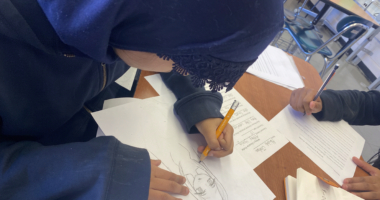Standing in front of the brightly bannered doorway, I took a deep breath and prepared to enter the now-familiar classroom in Brooklyn, where my internship takes place. It is the first class of 2015 and I am ready to begin on a fresh note. As I had learned over the past several weeks in my Teaching Artist Training & Internship Program (TATIP) residency, it is vital to set intention and to clear out any noise – internal or external – in order to make room for the artistic magic waiting within.
Already, the opening ritual held some surprises. Usually, it was a call-and-response song. Today, however, my mentors, the classroom teachers and I attempted to herd twenty first-graders into some semblance of a circle on a very small (and square) rug. We had instructed them to arrange themselves in a gender pattern, alternating boys with girls. It took several tries for these directions to sink in. Sensing that some energy needed to be released, one of my mentors led the students in a game, going around the circle and giving each student a chance to say their name and create their own special gesture.
Once everyone was seated, a large sheet of paper was placed in the middle of the circle, along with a miniature tree stump. “Tree rings,” my mentor explained, “show how much the tree has grown. The bigger the ring is, the more the tree grew that year. Can you think of ways that you have grown as a student this year?” We passed the tree stump around the circle, and a variety of answers greeted her question. Better handwriting, more friendships, a larger vocabulary: the list went on and on.
Next, each student was asked to draw a circle on the paper in the center that would serve as their personal tree ring. The Teaching Artist demonstrated this by making the first ring in the middle, noting the limitations of the paper and the need to be mindful of the following classmates. As each child came to the middle of the circle, one by one, subtle behaviors began to emerge. The cramped rug space meant that some had to shift aside and make way for each new artist to reach the paper. Someone’s marker ran out of juice and another volunteered theirs to be used. One little girl, the first to do so, made her ring looped and squiggly, and her classmates offered up praise. When another child had a pen with a sharp tip that threatened to poke a hole through the paper, those closest to the paper held the edges down so it stayed steady.
Afterwards, we reflected on community, and how it had developed within our class during these weeks together. One of my mentors captured an audio clip of student responses:
This particular lesson stood out to me as a microcosm of the practices I have learned during my seminars with Community-Word Project’s TATIP program. My two mentors have truly made community the focal point of their residency by scaffolding each lesson mindfully. Even though we were not actively working on one of the larger collaborative project goals this day, we were still building on the underlying themes during these fun activities. Through all of their interactions with students, I have observed my teaching artist guides create and facilitate a safe artistic space for every participant, on both an individual and a communal level.
The techniques they use to accomplish this are varied: through setting expectation, modeling behaviors, and treating all in the room with equal respect. When challenges arise with behavior – for instance, during the opening ritual on this particular day – every effort is made to refocus excess energy, but also to direct attention to students behaving appropriately. For instance, when a question is asked and twenty bodies start wriggling in their seats and thrashing their hands in the air (“Ooh me! Pick me!”), either Katie or Max will calmly repeat, “I will only call on strong, silent hands who know the answer.” To avoid confusion and also to level the playing field, they always display the action they expect for any given activity before asking students to perform it. Again, in this instance, Katie stepped into the circle and drew her tree ring first, clarifying that we should all be good audience members, leave room on the paper for the people behind us, etc.
My mentors hold their students to high standards: I have never seen them baby or talk down to any child, but rather consistently give them the ultimate responsibility to choose how they wish to act. This firmness does not mean that they act tyrannical – quite the opposite. If a student is having a bad day or acting out of character, I have witnessed them approach the situation with humanity and attempt to understand what is causing this behavior to surface. When the Teaching Artists relate to each other, the classroom teachers, and every student with this same level of compassion and respect, it opens the floor for students to embody this example when interacting with each other, something that I saw unfold in the ripples of our tree rings.
My mentors establish an environment where students can succeed through a fusion of both the creative process and critical thinking. With this activity, students were given a common object – the tree stump – and experimented with it in creative ways that shifted their perception. Yet they also simultaneously performed a meta-analysis about its meaning in their lives and in their classroom. What did we learn? We worked as a team. We worked together. Creative and critical thinking are interconnected, and equally important for learning to occur.
Some tree rings are wider or bigger, some smaller or thinner. Yet they all have something vital to contribute to the whole, and they all indicate growth.
-Megan Skelly, Writer, TATIP Trainee



